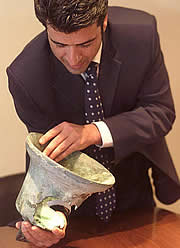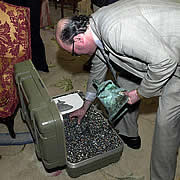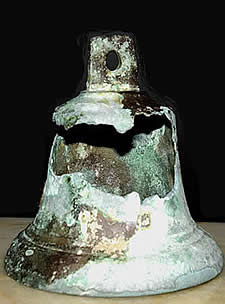
|
17 February 2003 A bell purported to be that of Christopher Columbus' flagship, the Santa Maria, was on pre-auction display at the Hotel Ritz in Madrid on Monday Feb. 17, 2003. The once shapely bell, now turquoise in color from extensive undersea corrosion with a gaping hole in the upper part, is about 10 inches (25 centimeters) in height and diameter, and weighs about 31 pounds (14 kilograms). (AP Photo/ EFE, M.H. de Leon) |
'Santa Maria bell'—
auction to open at
$1 million,
but scientists are skeptical
By MIKE TONER
Atlanta Journal-Constitution
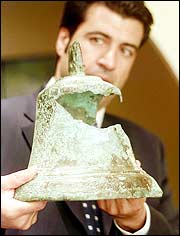
Denis Doyle / AP
2/8/03— David del Val Catala, chairman and chief executive of the auction house Gestion de Activos y Subastas, holds up a bell which was found off the coast of Portugal and is purported to be that of Christopher Columbus' flagship, the Santa Maria, on his his voyage to America. |
|
2/6/03— David del Val Catala, examines the bell, which is to be auctioned off Feb. 20, 2003, with the bidding starting at 1$ million. (AP Photo/Denis Doyle) |
|
2/17/03— Chief auctioneer, Francisco J. Garcia-Santos puts the bell in a heavy-duty protective case at the Hotel Ritz in Madrid, Spain a few moments before it is seized by Spanish police at the request of the Portuguese government. Portugal argues that although the bell was located in the wreckage of a Spanish galleon, it was found in Portugese waters, and therefore belongs to Portugal. (AP Photo/Paul White) |
The planned sale in Madrid, Spain, this week of "the ship's bell of the Santa Maria" is stirring a tempest of controversy that would make Columbus, whose life and legacy were rife with acrimony, feel right at home.
As bells go, the corroded hunk of bronze and tin going on the auction block Thursday at Madrid's Hotel Ritz isn't much to look at. There's a gaping hole in one side. Shells and marine encrustations attest to its many years on the ocean bottom.
But it is the bell's purported Columbus connection, not aesthetics that has prompted the Barcelona-based auction house Gestion de Activos y Subastas to set the opening bid at $1 million. Buoyed by advance reports of the sale on CNN and international wire services, the firm hopes the bell will ring up as high as $10 million.
Italian diver Roberto Mazzara, who found the bell off the coast of Portugal in 1994, claims it's the "only known artifact of the history of American discovery" -- the bell that was aboard the admiral's flagship when he reached the New World in 1492.
Independent archaeologists, scholars and archivists scoff at the claim, which they say is largely based on supposition and a fragmented chain of custody that spans a half-century of Spanish colonization of the Americas.
"If these people were claiming that this bell had hung around the neck of the Loch Ness monster it would be about as credible," says Portuguese archaeologist Felipe Castro, now at Texas A&M University.
"It looks like it could indeed be a 16th-century bell," says Julia King, president of the Society for Historical Archaeology. "But the idea that it came from the Santa Maria is really pushing it."
Despite the skepticism -- and the possibility that the bell might be claimed as cultural property by Spain or Portugal -- officials of Gestion de Activos y Subastas say the sale will be held.
The firm's chairman, David del Val Catala, says interest from potential bidders has been intense.
"Whether it is purchased by a public institution or a private concern, we hope it will end up where it will be seen by many people," he said. The Spanish government, he said, would be allowed to claim the bell -- but only if it matches the highest bid.
The auction house has been assertive in publicizing the bell's purported pedigree. It has hired a New York public relations firm to promote the sale and publish brochures, a compact disc and Internet documents from consultants the company says prove the bell is "the real McCoy."
Mazzara says he found the 12-inch bell partially buried in the sand about 150 yards off the beach near the Portuguese fishing village of Barcos. Mazzara was diving there in hopes of finding a vessel called the San Salvador I, one of three Spanish ships that ran aground in a storm in 1555 while carrying cargo from the New World to Spain.
Surprising find
Recovery efforts by Mazzara and a diving companion -- and an apparent scuffle over possession -- apparently created at least part of the gaping hole that now defaces the bell. He concluded later that the bell had sailed with Columbus in 1492 and was being returned to Spain when the ship carrying it sank in Portuguese waters. Mazzara himself said he was surprised to find such a small relic so far from the rest of the wreck.
"The first thing I thought was, 'This thing should not be here,' " Mazzara told The Associated Press. "The feeling I had was like finding a refrigerator inside the treasure chamber of the Great Pyramid."
Whose bell it is and how it got there is something that Mazzara and the auction house are more certain of than their critics.
History records that Columbus' flagship ran aground off Hispaniola, along what is now the north coast of Haiti, on Christmas Day 1492.
With only two small ships remaining for the voyage back to Spain, he put some of his men ashore, left supplies and promised to come back for them.
'Shocking assertion'
When Columbus returned a year later, the men had disappeared, and the settlement, La Navidad, had burned to the ground. Mazzara and the auction house theorize that Columbus' second expedition salvaged what was left of the encampment -- including the Santa Maria's bell -- and took it with them.
Independent experts say that's pure speculation.
"We don't even know that Santa Maria had a bell," says Donald Keith, an archaeologist with Ships of Discovery, an underwater archaeology institute in Corpus Christi, Texas, that specializes in early shipwrecks.
Keith has excavated several 16th-century Spanish vessels in the Bahamas and Panama and said he has never encountered one with a bell.
"There is also no indication that La Navidad ever had a bell," agrees University of Florida archaeologist Kathleen Deagan, who has spent years researching the settlement and excavating near En Bas Saline, Haiti, where it is believed to have been located. "It's a pretty shocking assertion to make without any evidence."
"There is no hard evidence or any hard archival evidence that this is the Santa Maria's bell," said John de Bry, the head of the Center for Historical Archaeology in Melbourne Beach, Fla.
Exploring history
No trace has ever been found of the Santa Maria or the wooden fortress built at La Navidad, but de Bry and Deagan are planning this year to resume the search, which had been suspended for more than a decade because of political turmoil in Haiti.
The claim by Mazzara and the auction house is based, in part, on a ship's manifest from Spain's Archive of the Indies.
The handwritten document suggests that a bell was aboard the San Salvador I when it sank off Portugal in 1555.
The ship's cargo, however, had originated in San Juan, Puerto Rico.
There is no explanation for how the Santa Maria's bell, if it ever existed, got from Haiti to Puerto Rico or what happened to it between 1492 and 1555.
The existence of such a bell hangs on a brief reference in the manifest, in flowing Spanish script, to gold and silver and the "signo" of the Villa de Navidad.
Interpreting the past
Claudio Bonifacio, the auction house's archival consultant, says in 16th-century Spanish vernacular, the term "signo" -- literally translated as "sign" -- was sometimes used to mean "bell." "It would make no sense for this not to be the bell of the Santa Maria," he said.
Other archivists aren't so sure.
"I have never seem 'signo' used for bell," says R. Wayne Childers, a Florida archivist who has translated thousands of pages of early Spanish documents. "Nothing in these documents in any way supports the idea that the bell of the Santa Maria was on the San Salvador."
Technical studies by the auction house's consultants at the University of Zaragoza and the Technological Institute of Aragon attest that the bell is old, but they are ambiguous about its exact age and origin.
Adding up conclusions
One analysis finds that its metallurgical composition is "in accordance with alloy used to build bells since the Roman period." It concludes that the bell "without doubt could belong to the 15th century" and has probably been on the ocean's bottom for "more than 400 years."
Mazzara and the auction house say black stains on the bell may have been inflicted during the burning of the La Navidad settlement.
But Robert Neyland, chief of underwater archaeology for the U.S. Navy, said there's a more likely explanation.
"Black staining is very common on metal objects that have been underwater for a long time," he said. "The evidence that it went through a fire, or that it's the bell of the Santa Maria, is pretty tenuous."
Del Val Catala acknowledges that no single bit of evidence conclusively links the bell to Columbus -- only the "sum of many conclusions." "Nobody can guarantee that this is the bell of the Santa Maria," he said. "But we believe it is."
But some archaeologists say the sum of the auction house's evidence is greater than its parts.
"Strange things do turn up in the sea," said Roger Smith, head of the underwater archaeology department at Florida State University. "The real problem is identifying what you've found. That's why we need archaeologists doing this kind of work and not auction houses."
"It would be extraordinary if this really were the bell of the Santa Maria," said Ships of Discovery archaeologist Toni Carrell. "But extraordinary claims require extraordinary proof, and this isn't it."
Bell Said to Be From Columbus Era Seized
Copyright 2003 by The Associated Press (via ClariNet)
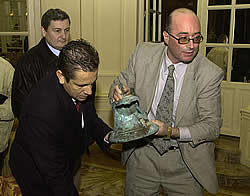 |
|
02/17/03— Police officers seize the bell believed to be that of the Santa Maria, Christopher Columbus' flagship, at the Hotel Ritz in Madrid on Monday Feb. 17, 2003. The police arrived at the hotel as the Gestion de Activos y Subastas auction house prepared to put the bell on view for potential bidders ahead of Thursday's planned sale. (AP Photo/Paul White) |

|
|
02/17/03— Plainclothes police officers take away the bell, pending court action in Madrid. (AP Photo/Paul White) |
MADRID, Spain (AP) -- A rusty, broken bell that may have come from Christopher Columbus' flagship -- the Santa Maria -- was seized by police Monday, shortly before it was to be auctioned for a starting bid of $1 million.
A Spanish judge ordered the seizure so Portugal could investigate its claim to the artifact, which a diver discovered in a sunken Spanish galleon in Portuguese waters.
While experts concede they may never be able to prove beyond a doubt the bell came from the Santa Maria, that possibility -- and its potential sale -- grabbed the attention of Portuguese officials who filed a court order to stop the auction.
"We're very happy to hear this," Rosa Amora, deputy director of the Portuguese Archaeological Institute, said of the seizure. "It's a small victory in a long war."
The Spanish government had no immediate comment.
Police seized the bell from the Hotel Ritz, in downtown Madrid, where the sale was to have taken place Thursday. They used a protective case to remove the badly corroded bell, which is 10 inches tall, weighs about 30 pounds and has several fractures and a large hole.
"It came as a total surprise this morning," said David del Val Catala, director of the auction house Gestion de Activos y Subastas. "For the moment the auction has been suspended. We are now studying the order and preparing our case."
The auction house and the Italian diver who recovered the artifact in 1994 insist they have done nothing wrong.
"All the dealings concerning the bell have been carried out with total transparency," said del Val Catala. "Nothing has been kept from the Portuguese authorities or Spanish authorities."
Italian diver Robert Mazzara found the bell off the coast of northern Portugal inside the wreck of the San Salvador, which sank in 1555 while sailing from the Americas to Spain.
At first, neither Portugal nor Spain expressed much interest in the bell, Del Val Catala said. That changed after Mazzara and the auctioneers commissioned studies to prove the bell once belonged to the Columbus ship.
Now, Portuguese authorities want to examine that evidence, and perhaps proceed with a legal claim, said Amora, of the archaeological institute.
Mazzara told officials from both countries about his find in 1994, but at the time, he only suspected the bell was from the Santa Maria.
Portuguese authorities say the diver promised to inform them when he had proof of the relic's history, but they never heard from him again. Mazzara was not immediately available for comment. The auction house has now been given three days to persuade the court that it should remain in the hands of its client.
